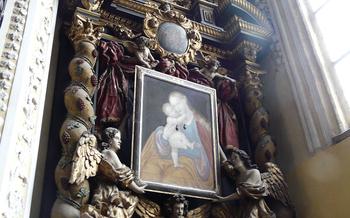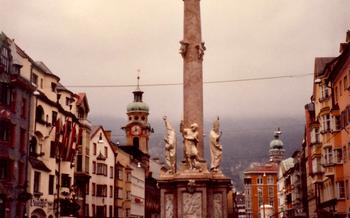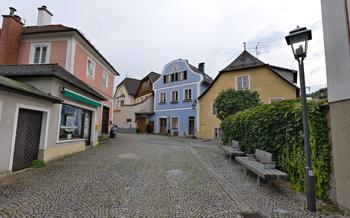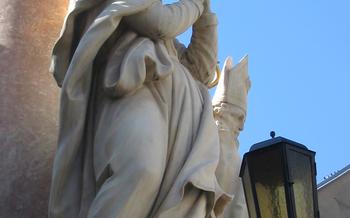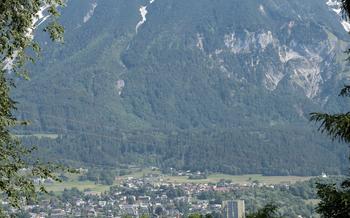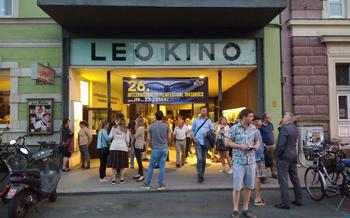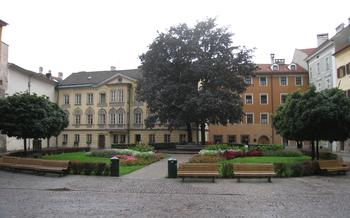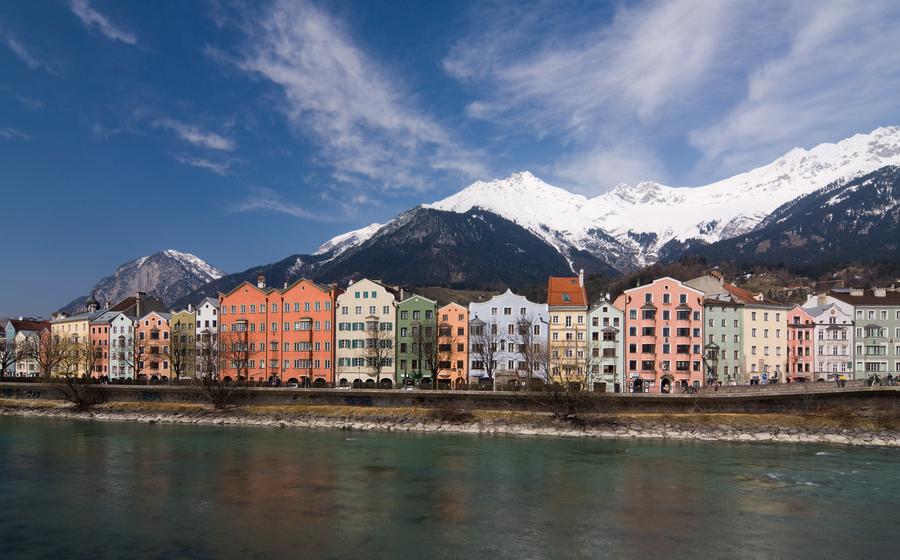
Kaiserliche Jagdschloss Innsbruck
- Imperial Palace of Innsbruck: A Historical Jewel
- Exploring the Palace Grounds
- Hofkirche: A Treasure Trove of Art
- Giant Hall: Witnessing Imperial Grandeur
- Court Church: A Spiritual Oasis
- Goldenes Dachl: A Symbol of Opulence
- Tyrolean State Museum: A Journey Through History
- Ambras Castle: A Renaissance Masterpiece
- Hofgarten: A Serene Green Oasis
- Innsbruck Cathedral: A Gothic Gem
- City Tower: A Panoramic Perspective
- Triumphal Arch: A Symbol of Victory
- Innsbruck Zoo: A Wildlife Adventure
- Insider Tip: Hidden Gems of Innsbruck
Imperial Palace of Innsbruck: A Historical Jewel
In the heart of Innsbruck, nestled amidst the stunning Tyrolean Alps, lies the magnificent Imperial Palace, a testament to the rich history and grandeur of Austria. Once the lavish residence of the Habsburg dynasty, this architectural masterpiece transports visitors to a bygone era of imperial splendor. Built in the 15th century by Emperor Maximilian I, the palace underwent several expansions and renovations over the centuries, resulting in a harmonious blend of Gothic, Renaissance, and Baroque styles. Its opulent halls, intricate courtyards, and awe-inspiring artworks provide a glimpse into the lives of the Habsburg monarchs who once graced its chambers. Today, the Imperial Palace stands as a living museum, inviting visitors to explore its fascinating stories and immerse themselves in the splendor of a bygone era.
Exploring the Palace Grounds
The Imperial Palace of Innsbruck is surrounded by sprawling grounds that offer a delightful blend of natural beauty and historical significance. Take a leisurely stroll through the lush gardens, adorned with vibrant flowers, manicured lawns, and towering trees. Admire the intricate sculptures, fountains, and monuments that grace the grounds, each telling a story of the palace's rich past. From the gardens, you can capture breathtaking views of the surrounding mountains, providing a stunning backdrop to your visit. The palace grounds are also a popular venue for special events and concerts during the summer months, offering a unique and enchanting setting for cultural experiences.
Hofkirche: A Treasure Trove of Art
The Hofkirche, or Court Church, is an architectural masterpiece and a treasure trove of art, serving as a testament to the Habsburg dynasty's power and devotion. Built in the 16th century, it was designed to be the final resting place for Emperor Maximilian I, known as "the Last Knight."
The church is a stunning example of Gothic architecture, with intricate carvings and soaring vaults. The interior is adorned with exquisite stained glass windows, depicting scenes from the life of Christ and the Habsburg family.
The most famous feature of the Hofkirche is the Silver Chapel, a masterpiece of Renaissance art. Commissioned by Maximilian I, it is a breathtaking work of art, made of over 2,500 silver tiles and featuring intricate reliefs depicting scenes from the life of Mary, the mother of Jesus.
The Hofkirche is also home to the elaborate tombs of Emperor Maximilian I and his family. These tombs are adorned with life-size bronze figures of the Habsburgs, each showcasing their individual personalities and achievements.
A visit to the Hofkirche is a journey through history, art, and spirituality. It offers a glimpse into the lives and beliefs of the Habsburg dynasty, and leaves visitors in awe of the artistry and craftsmanship of its time.
Giant Hall: Witnessing Imperial Grandeur
The Giant Hall, known as the Riesensaal in German, is an awe-inspiring testament to the grandeur of the Habsburg dynasty. Built in the 16th century, it served as a ceremonial and banquet hall for the imperial court, hosting lavish feasts, receptions, and celebrations. With its impressive dimensions, intricate architectural details, and historical significance, the Giant Hall is a must-see for anyone visiting the Hofburg Innsbruck.
Step inside the vast hall, and you'll be captivated by its sheer size. Towering walls adorned with ornate stucco work, a vaulted ceiling with intricate frescoes, and gleaming chandeliers create an atmosphere of opulence and grandeur. Along the walls, an impressive collection of portraits depicts Habsburg rulers and their families, offering a glimpse into the dynasty's rich history.
The Giant Hall has witnessed countless important events throughout the centuries. It served as the setting for lavish banquets, where the Habsburg court entertained distinguished guests with music, dance, and culinary delights. It also hosted official ceremonies, such as the investiture of knights and the reception of foreign dignitaries. The hall's acoustics are renowned, making it an ideal venue for concerts and performances, which are occasionally held to this day.
Today, visitors can explore the Giant Hall as part of a guided tour of the Hofburg Innsbruck. Marvel at the intricate details of the ceiling frescoes, which depict scenes from Tyrolean history and mythology. Admire the impressive portraits of Habsburg rulers, each with their own unique story to tell. And imagine the grandeur of the events that once took place within these walls, as you step back in time to experience the imperial splendor of the Habsburg dynasty.
Court Church: A Spiritual Oasis
Built in the 18th century, the Court Church stands as a testament to the Baroque architectural style that dominated Europe during that period. Its intricate ceiling frescoes, painted by renowned artists such as Matthäus Günther, depict scenes from the Old and New Testaments, creating a visually stunning and awe-inspiring ambiance. The altarpiece, a masterpiece carved from white marble, showcases the Assumption of the Virgin Mary, surrounded by angels and cherubs. Other religious artworks, including sculptures and paintings, adorn the church's interior, adding to its spiritual and artistic significance.
The Court Church holds a special place in Innsbruck's history as it was closely connected to the Imperial Palace and the Habsburg dynasty. The imperial family used the church for religious services and ceremonies, further emphasizing their deep-rooted faith and connection to the Catholic Church. Today, the Court Church remains a popular destination for both locals and tourists, offering a serene and spiritual oasis amidst the bustling city center.
Goldenes Dachl: A Symbol of Opulence
In the heart of Innsbruck's Old Town, nestled amidst colorful buildings and bustling streets, lies a magnificent architectural wonder - the Goldenes Dachl (Golden Roof). This iconic landmark, dating back to the 15th century, is a testament to the opulence and grandeur of the Habsburg dynasty that once ruled over the region.
The Goldenes Dachl is renowned for its stunning golden roof, composed of over 2,657 fire-gilded copper tiles that shimmer in the sunlight, creating a mesmerizing spectacle. The intricate Gothic-style balcony beneath the golden roof is adorned with delicate tracery and sculptures, adding to its charm and elegance.
This lavish balcony was commissioned by Emperor Maximilian I to serve as a viewing platform for special occasions and festivities. From here, the Habsburg rulers and their guests would watch processions, tournaments, and other grand events that took place in the square below.
The Goldenes Dachl stands as a symbol of the wealth and power of the Habsburgs, who ruled over Tyrol for centuries. It is a reminder of a time when Innsbruck was a thriving center of commerce and culture, and the city's importance as a strategic gateway to the Alps.
Today, the Goldenes Dachl remains one of Innsbruck's most beloved landmarks, attracting visitors from around the world. It is a popular spot for taking photos, admiring the intricate craftsmanship, and soaking in the vibrant atmosphere of the Old Town.
Tyrolean State Museum: A Journey Through History
Nestled in the heart of Innsbruck, the Tyrolean State Museum stands as a testament to the rich history and diverse culture of Tyrol. Established in 1823, this esteemed institution boasts a treasure trove of artifacts, artworks, and exhibits that paint a vivid tapestry of the region's past and present.
The museum's extensive collection spans a wide range of disciplines, including Tyrolean history, art, culture, and natural history. Visitors can embark on a journey through time, exploring the region's prehistoric roots, medieval grandeur, and modern-day transformations.
Among the highlights of the museum is the renowned Ötzi the Iceman exhibit. This captivating display showcases the remarkably preserved remains of a 5,300-year-old man who was discovered frozen in the Ötztal Alps. Ötzi's well-preserved clothing, tools, and belongings provide a fascinating glimpse into the lives of Neolithic people.
The Tyrolean State Museum also houses an impressive collection of Tyrolean art, featuring works by renowned local artists such as Albin Egger-Lienz and Franz von Defregger. These masterpieces capture the essence of Tyrolean landscapes, traditions, and daily life.
In addition to its permanent exhibits, the museum regularly hosts temporary exhibitions on a variety of topics, ensuring that there is always something new to discover. Educational programs and workshops are also offered, providing visitors with an opportunity to delve deeper into Tyrolean history and culture.
A visit to the Tyrolean State Museum is an essential experience for anyone seeking to understand the rich heritage of Tyrol. Through its diverse collection and engaging exhibits, the museum offers a captivating journey through the region's past and present, leaving visitors with a profound appreciation for the unique character of this captivating Alpine land.
Ambras Castle: A Renaissance Masterpiece
Nestled on a hill overlooking Innsbruck, Ambras Castle stands as a testament to the grandeur of the Renaissance era. Built in the 16th century by Archduke Ferdinand II, this magnificent castle boasts a unique blend of architectural styles, with its well-preserved Renaissance facade and Gothic elements. The surrounding gardens, meticulously manicured and adorned with fountains and sculptures, create an enchanting ambiance that transports visitors back in time.
Inside the castle, a treasure trove of wonders awaits. The Chamber of Art and Curiosities, a highlight of the museum, houses an eclectic collection of artifacts from around the world, including intricate armor, exotic weapons, and rare natural specimens. Marvel at the breathtaking Spanish Hall, with its ornate ceiling paintings depicting scenes from mythology and history. The Hall of Antiquities showcases a collection of Roman and Greek sculptures, while the Hall of Portraits features a gallery of Habsburg family members and other notable figures.
Ambras Castle is not just a museum; it's a living testament to the Habsburg dynasty's rich history and patronage of the arts. As you wander through its halls and chambers, imagine the lavish banquets, courtly gatherings, and intellectual discussions that once took place within these walls. The castle's legacy continues to inspire and enchant visitors from all corners of the globe.
Hofgarten: A Serene Green Oasis
Innsbruck's Hofgarten, nestled between the Imperial Palace and the Tyrolean State Museum, offers a tranquil retreat from the bustling city. With a history dating back to the 16th century, this serene green oasis was once a private garden for the Habsburg rulers. Today, it's a beloved public park, inviting visitors to stroll along its manicured paths and admire its diverse flora.
The Hofgarten showcases a variety of plants and flowers, including a magnificent rose garden with over 1,000 varieties of roses. Sculptures and fountains adorn the park, adding an artistic touch to its natural beauty. The park's peaceful ambiance makes it a popular spot for locals and tourists alike to relax, enjoy a picnic, or simply soak up the sunshine.
One of the highlights of the Hofgarten is the Hofburg Chapel, a small but exquisite Baroque chapel located at the park's southern end. The chapel, built in the 17th century, features a richly decorated interior with frescoes, sculptures, and a stunning altarpiece. It serves as a reminder of the park's historical connection to the Habsburg dynasty.
Innsbruck Cathedral: A Gothic Gem
In the heart of Innsbruck's historic old town stands the majestic Innsbruck Cathedral, a testament to the city's rich religious heritage and Gothic architectural prowess. Constructed between the 12th and 15th centuries, the cathedral underwent several expansions and renovations, resulting in a harmonious blend of Romanesque and Gothic styles. Its towering spires and intricate façade adorned with sculptures and reliefs captivate visitors from afar.
Step inside the cathedral to marvel at its awe-inspiring interior. The nave is supported by slender pillars, creating a sense of spaciousness and grandeur. The High Altar, crafted from Carrara marble and adorned with intricate carvings, is a masterpiece of Gothic art. The stained glass windows, depicting biblical scenes and stories of saints, bathe the interior in a kaleidoscope of colors.
Innsbruck Cathedral is not merely a place of worship but also a repository of history and art. The Tyrolean State Museum, located within the cathedral complex, houses a collection of sacred art, including paintings, sculptures, and liturgical objects. The cathedral's connection to the Hofkirche, the Habsburg imperial mausoleum, further enhances its significance as a symbol of Tyrolean history and devotion.
Whether you're a history buff, an art enthusiast, or simply seeking spiritual solace, Innsbruck Cathedral offers a profound and enriching experience. Its architectural splendor, artistic treasures, and spiritual atmosphere make it a must-visit destination in the heart of the Tyrolean capital.
City Tower: A Panoramic Perspective
In the heart of Innsbruck's Old Town, the City Tower stands tall as a symbol of the city's rich history. Dating back to the 14th century, this imposing structure was once part of the city's fortifications and served as a watchtower. Today, it offers visitors a unique opportunity to ascend to its observation deck and enjoy breathtaking panoramic views of Innsbruck and its stunning surroundings.
The City Tower stands at an impressive height, providing visitors with an unparalleled perspective of the city. From the observation deck, you can admire the historic buildings of Innsbruck's Old Town, including the Golden Roof, the Hofburg, and the Court Church. Gaze upon the majestic peaks of the surrounding mountains, including the Nordkette range and the Patscherkofel. On a clear day, you can even catch a glimpse of the Zugspitze, Germany's highest mountain.
Reaching the observation deck is an experience in itself. You can choose to climb the tower's 150 steps or take the convenient elevator. Along the way, informative exhibits provide insights into the history of the tower and its significance to Innsbruck.
Once at the top, you'll be rewarded with breathtaking views that stretch far and wide. Take your time to soak in the beauty of Innsbruck and its surroundings. Capture the moment with your camera or simply relax and enjoy the panoramic vistas.
Whether you're a history buff, a nature lover, or simply someone who appreciates stunning views, the City Tower is a must-visit attraction in Innsbruck. Don't miss the opportunity to ascend to its observation deck and experience the city from a whole new perspective.
Triumphal Arch: A Symbol of Victory
Innsbruck's Triumphal Arch stands as a testament to the military prowess and imperial grandeur of Emperor Maximilian I. Constructed in 1765, this triumphal arch commemorates Maximilian's victories over his enemies and celebrates the power and prestige of the Habsburg dynasty.
The arch is a masterpiece of Renaissance architecture, designed by the Italian architect Albrecht Dürer. It is adorned with elaborate reliefs and sculptures depicting mythological and historical scenes, alluding to Maximilian's triumphs and his lineage. The arch's central panel features a depiction of Maximilian on horseback, surrounded by allegorical figures representing virtues such as Justice and Fortitude.
Located near the Hofburg Innsbruck and the Hofgarten, the Triumphal Arch is a prominent landmark in the city center. It serves as a reminder of Innsbruck's rich history and its connection to the Habsburg dynasty. Visitors can admire the arch's intricate carvings and marvel at the stories they tell, gaining a deeper appreciation for the city's heritage.
Innsbruck Zoo: A Wildlife Adventure
Nestled amidst the picturesque Tyrolean landscape, Innsbruck Zoo offers a captivating wildlife experience for visitors of all ages. Established in 1967, the zoo is dedicated to the conservation and welfare of both Alpine and exotic species, providing a safe haven for over 150 different animal species.
Explore the diverse habitats that replicate the natural environments of these fascinating creatures, including spacious enclosures for big cats, playful monkeys, graceful birds, and slithering reptiles. Learn about the unique adaptations and behaviors of each species through interactive exhibits and educational displays.
Families will delight in the opportunity to witness feeding times, where they can observe the animals' natural instincts and behaviors up close. Children can participate in educational programs and workshops, fostering a love for wildlife and the importance of conservation.
Don't miss the chance to encounter the zoo's beloved Alpine animals, such as the majestic ibex, agile marmots, and playful chamois, all thriving in their natural mountain habitat. Immerse yourself in the wonders of the natural world and discover the beauty of these incredible creatures at Innsbruck Zoo.
Insider Tip: Hidden Gems of Innsbruck
Beyond the popular attractions, Innsbruck offers a treasure trove of hidden gems waiting to be discovered. For those seeking unique experiences, here are some insider tips:
-
The Hofburg Chapel: Nestled within the Hofburg complex, this exquisite chapel boasts stunning frescoes, intricate carvings, and a serene atmosphere. It's a hidden gem often overlooked by tourists but offers a glimpse into the spiritual side of the Habsburg dynasty.
-
The Wilten Basilica: Located in the Wilten neighborhood, this Baroque masterpiece features a magnificent interior adorned with frescoes, sculptures, and a grand altar. Its serene ambiance and historical significance make it a must-visit for art and architecture enthusiasts.
-
The Hungerburgbahn: Take a ride on this unique funicular railway that connects the city center to the Hungerburg mountain station. Enjoy breathtaking views of the city and the surrounding mountains during the scenic journey.
-
The St. Nikolaus Church: This charming Gothic church, located in the Old Town, is known for its beautiful stained glass windows depicting scenes from the life of St. Nicholas. It's a hidden gem that offers a peaceful retreat from the bustling city streets.
-
The Alpine Zoo: Perched on the hillside overlooking Innsbruck, this zoo specializes in Alpine wildlife. Observe fascinating animals like ibex, marmots, and chamois in their natural habitat while enjoying panoramic views of the city.
